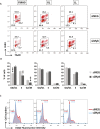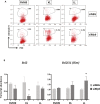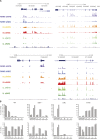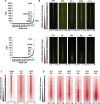Dependence on Myb expression is attenuated in myeloid leukaemia with N-terminal CEBPA mutations
- PMID: 30877232
- PMCID: PMC6421631
- DOI: 10.26508/lsa.201800207
Dependence on Myb expression is attenuated in myeloid leukaemia with N-terminal CEBPA mutations
Abstract
Mutations at the N- or C-terminus of C/EBPα are frequent in acute myeloid leukaemia (AML) with normal karyotype. Here, we investigate the role of the transcription factor Myb in AMLs driven by different combinations of CEBPA mutations. Using knockdown of Myb in murine cell lines modelling the spectrum of CEBPA mutations, we show that the effect of reduced Myb depends on the mutational status of the two Cebpa alleles. Importantly, Myb knockdown fails to override the block in myeloid differentiation in cells with biallelic N-terminal C/EBPα mutations, demonstrating for the first time that the dependency on Myb is much lower in AML with this mutational profile. By comparing gene expression following Myb knockdown and chromatin immunoprecipitation sequencing data for the binding of C/EBPα isoforms, we provide evidence for a functional cooperation between C/EBPα and Myb in the maintenance of AML. This co-dependency breaks down when both alleles of CEBPA harbour N-terminal mutations, as a subset of C/EBPα-regulated genes only bind the short p30 C/EBPα isoform and, unlike other C/EBPα-regulated genes, do so without a requirement for Myb.
© 2019 Volpe et al.
Conflict of interest statement
The authors declare no conflicts of interest.
Figures











Similar articles
-
Gain-of-Function Effects of N-Terminal CEBPA Mutations in Acute Myeloid Leukemia.Bioessays. 2020 Feb;42(2):e1900178. doi: 10.1002/bies.201900178. Epub 2019 Dec 23. Bioessays. 2020. PMID: 31867767 Free PMC article. Review.
-
Identification of gene targets of mutant C/EBPα reveals a critical role for MSI2 in CEBPA-mutated AML.Leukemia. 2021 Sep;35(9):2526-2538. doi: 10.1038/s41375-021-01169-6. Epub 2021 Feb 23. Leukemia. 2021. PMID: 33623142 Free PMC article.
-
C/EBPα-p30 confers AML cell susceptibility to the terminal unfolded protein response and resistance to Venetoclax by activating DDIT3 transcription.J Exp Clin Cancer Res. 2024 Mar 13;43(1):79. doi: 10.1186/s13046-024-02975-3. J Exp Clin Cancer Res. 2024. PMID: 38475919 Free PMC article.
-
The N-terminal CEBPA mutant in acute myeloid leukemia impairs CXCR4 expression.Haematologica. 2014 Dec;99(12):1799-807. doi: 10.3324/haematol.2014.107821. Epub 2014 Sep 5. Haematologica. 2014. PMID: 25193961 Free PMC article.
-
[Roles of CEBPA mutation and expression abnormality in acute myeloid leukemia - review].Zhongguo Shi Yan Xue Ye Xue Za Zhi. 2012 Oct;20(5):1256-60. Zhongguo Shi Yan Xue Ye Xue Za Zhi. 2012. PMID: 23114160 Review. Chinese.
Cited by
-
Gain-of-Function Effects of N-Terminal CEBPA Mutations in Acute Myeloid Leukemia.Bioessays. 2020 Feb;42(2):e1900178. doi: 10.1002/bies.201900178. Epub 2019 Dec 23. Bioessays. 2020. PMID: 31867767 Free PMC article. Review.
-
The AML-associated K313 mutation enhances C/EBPα activity by leading to C/EBPα overexpression.Cell Death Dis. 2021 Jul 5;12(7):675. doi: 10.1038/s41419-021-03948-6. Cell Death Dis. 2021. PMID: 34226527 Free PMC article.
-
Gene expression profiling and pathway analysis in acute myeloid leukaemia-normal karyotype patients.PLoS One. 2025 Sep 5;20(9):e0328911. doi: 10.1371/journal.pone.0328911. eCollection 2025. PLoS One. 2025. PMID: 40911615 Free PMC article.
-
Reversal of MYB-dependent suppression of MAFB expression overrides leukaemia phenotype in MLL-rearranged AML.Cell Death Dis. 2023 Nov 23;14(11):763. doi: 10.1038/s41419-023-06276-z. Cell Death Dis. 2023. PMID: 37996430 Free PMC article.
-
Menin is necessary for long term maintenance of meningioma-1 driven leukemia.Leukemia. 2021 May;35(5):1405-1417. doi: 10.1038/s41375-021-01146-z. Epub 2021 Feb 4. Leukemia. 2021. PMID: 33542482 Free PMC article.
References
-
- Bereshchenko O, Mancini E, Moore S, Bilbao D, Mansson R, Luc S, Grover A, Jacobsen SE, Bryder D, Nerlov C (2009) Hematopoietic stem cell expansion precedes the generation of committed myeloid leukemia-initiating cells in C/EBPalpha mutant AML. Cancer Cell 16: 390–400. 10.1016/j.ccr.2009.09.036 - DOI - PubMed
Publication types
MeSH terms
Substances
Grants and funding
LinkOut - more resources
Full Text Sources
Medical
Molecular Biology Databases
